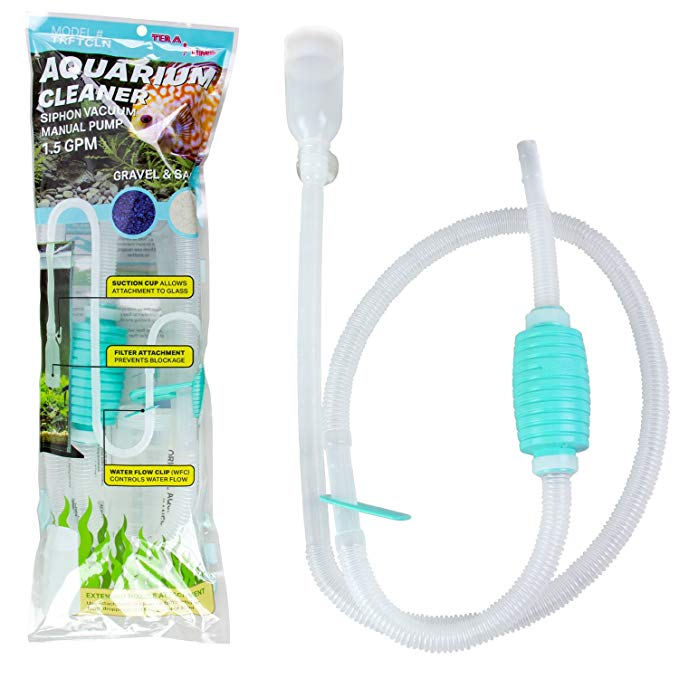Best Aquarium Cleaners

Your stunning aquarium will only stay beautiful if you put in effort into regular and meticulous maintenance. Not only that keeping your fish tank clean will ensure it always looks spotless and fabulous, but it will also ensure the fish and plant life in it are healthy and happy. However, when it comes to cleaning aquariums, it’s not as easy as taking a dish sponge and scrubbing away. It’s a thorough process that requires the right tools and supplies – without them, you won’t be able to get your fish tank looking spic and span.
Additionally, not all products are safe for the fauna and flora inhabiting the tank: you have to use safe aquarium cleaners to get the job done without endangering the tank’s inhabitants. While the process of carefully cleaning your fish tank might seem daunting or cumbersome, you shouldn’t let it overwhelm you. PetGuide.com’s resources on aquarium cleaners will help you choose the best and most efficient fish tank cleaning supplies, and our experts will guide you through the process, ensuring that no spot goes unmissed. In addition, we have some insider tips and tricks on minimizing the need for maintenance in the first place, by taking necessary preventative steps.
Top 5 Best Aquarium Cleaners
Aquarium Cleaner
Features
Available At
TERA PUMP Aquarium Cleaner (model: TRFTCLN)
-
- • 1.5 GPM Manual Aquarium Cleaner Siphon Pump
- • Works great with Sand or/and Gravel
- • BPA Free
-
- • Algae scrubber features unique handle design
- • Compact and ideal for medium glass freshwater/saltwater tanks
- • ABS+PVC Plastic
-
- • Removes algae from glass and acrylic aquariums
- • Includes one pad for acrylic and glass aquariums
- • Replacement pads are simple and easy to install
-
- • Self-Priming by using up and down motion to start water flow
- • Efficiently separates debris from gravel
- • BPA free
-
- • Reduces aquarium maintenance by cleaning gravel
- • Rapidly reduces organic waste
- • Beneficial for goldfish, cichlid and heavily populated aquariums
Keeping your fish tank clean is one of the most important things you can do to ensure the wellbeing of its inhabitants. Poor hygiene in the fish tank can lead to behavioral and health issues in fish, causing depression and suicidal behavior, as well as a myriad of illnesses. As a rule of thumb, the water in the tank should be changed on a weekly basis, but a lot will depend on the number and species of fish in it, whether or not you have any live plants, as well as the size of the tank itself. Contrary to popular belief, fish bowls and small aquariums are not easier to maintain; the bigger the fish tank, the less it gets dirty! Regardless of the size of your aquarium, there are things you should do on a regular basis, to make sure your tank is always in ship shape.
First, never let excess food float around and decay in the water; not only that it will impact the pH balance as it produces ammonia, but it will make the water murky and dirty. You should also check the water for any leftover food that could be decaying in there and making the water dirty, and remove any algae from the glass. For routine cleaning, a magnetic glass cleaner is a heaven sent, as it won’t require you to put in your whole arm to clean it, and it will simultaneously clean both the outside and the inside of the glass. Of course, in tanks where algae are more persistent, not all aquarium cleaners will do the trick: relying on scrapers and razors is a safe bet, though. You could always get a live “cleaner crew” to help out with the little routine stuff. Instead of spending most of the time lurking to catch any waste floating around, get yourself living, swimming aquarium cleaners! Aquarium cleaner fish is often how people refer to some catfish species, as they’ll eat algae, as well as certain species of aquarium shrimp and snails that might feed on the fish waste, minimizing the effort you need to put into routine cleaning.
Cleaning the aquarium glass and making sure that water is fresh and clean are not the only routine clean ups you’ll need to do. Depending on your setup, you should take out the filter every two to a couple of weeks and thoroughly clean every bit of it, from the tubing to all the nooks and crannies of the filter’s casing. Of course, not all filter media are the same, and sometimes you’ll have to replace them rather than just rinse out the grime: fortunately, PetGuide.com has all the scoop on best types of aquarium filters as well as guides on how to properly clean them so you won’t have to worry you’ll ruin your aquarium equipment with your cleaning technique.
Of course, making sure that you clean your fish tank from top to bottom on a regular basis is an absolute must. As most, if not all, of the waste and debris that is produced in your aquarium, will end up at its bottom, it’s only logical to presume that you will have to clean the gravel substrate, too. but how are you supposed to clean aquarium gravel? Are you supposed to empty out the tank? Luckily, it’s not a complicated process when you have the right supplies. A water siphon can be used the same way you would use a normal vacuum cleaner- it will suck out all the debris and leave your substrate spotless.
While having all the right tools and fish-safe aquarium cleaners is a good start, you should make sure that you don’t disrupt the aquatic life inhabiting your tank. Sometimes, vigorous fish tank cleaning can destroy beneficial bacterial colonies that are keeping the oxygen at an optimum level, leading to serious issues with both flora and fauna in your aquarium. Follow PetGuide.com’s advice to make sure that your methods are not ruining the chemical balance of your water or stressing out the fish.
In reality, if you monitor your aquarium and stick to your maintenance routine, you shouldn’t ever have to do completely tear it down and completely clean out your fish tank. Sometimes, though, the only solution is to scrub everything from the last pebble to the filters, to remove the buildup of grime and bacteriae. Whether you want tips on regular maintenance or have gotten into a situation where the only solution is to do fish tank “spring cleaning”, we’ve got you covered. From guides to reviews, our experts make sure that you’re able to provide a beautiful and healthy environment for your fish.

Amy Tokic, Editor of PetGuide.com, is a passionate animal lover and proud pet parent of Oscar, a Shih Tzu/Chihuahua cross, and Zed, a Japanese Chin. Her love of animals began in kindergarten, when she brought her stuffed dog Snoopy into class with her every day. Now, she writes about her adventures in pet ownership and tirelessly researches products, news and health related issues she can share with other animal enthusiasts. In her free time, Amy loves perusing used book and record stores, obsessing over the latest pet products available and chasing squirrels with wild abandon (a habit attributed to spending too much time with her pooches).
More by Amy Tokic



























